The herb campanula (Campanula), also called the bell, is part of the Bellflower family. This genus unites more than 400 species that in nature can be found in regions with a temperate climate in Europe, the Caucasus, Central and Western Asia, as well as in some places in North America. The bell prefers to grow in forests, steppes, meadows, desert and rocky areas. The scientific name of this plant was formed from the word "campana", which translates as "bell", and "campanula" means "bell" in translation. In the people, this flower is also called the chebotk, the birdwort, the bell or the chenille. Below it will be described in detail how to grow campanula indoors.
Content
Brief description of cultivation
- Bloom... As a rule, it begins in the first summer weeks, and campanula fades at the beginning of the autumn period.
- Illumination... The plant needs a lot of bright light, but it must be diffused. It will grow best on an east- and west-facing windowsill. You can put the flower on the south window, but in this case it must be shaded in the afternoon.
- Temperature regime... During intensive growth - from 20 to 22 degrees, and in the winter months - from 12 to 14 degrees.
- Watering... During the growing season, water is systematically and abundantly, and during the rest period - 1 or 2 times every 30 days. Make sure that the earthy ball does not dry out completely.
- Air humidity... Campanula grows well at the level of humidity that is typical for living rooms. However, on hot days, as well as during the heating season, the plant is moistened from a sprayer with water at room temperature, this procedure is carried out in the evening.
- Fertilizer... In spring and summer, the flower is fed systematically 1 time in 7 days. To do this, use a liquid complex mineral fertilizer for flowering indoor plants. In the cold season, Campanula is not fed.
- Dormant period... It lasts a couple of months and starts after flowering, usually from October to December.
- Transfer... It is carried out in the spring at the very beginning of intensive growth.But experts do not advise replanting the old bush; instead, it is better to grow a new flower from a cutting.
- Reproduction... By dividing the bush, by seed, cuttings and young shoots with a heel.
- Pests... Spider mites and scale insects.
- Diseases... Gray rot.
Campanula features
The genus Campanula is represented by herbaceous plants, which can be perennials, biennials and annuals. Their leaf plates are solid and alternately located. As a rule, the corolla has a bell-shaped shape; it can be painted in lilac, white, blue, and also in various shades of purple. Flowers are single or they are part of paniculate or racemose inflorescences. The fruit is a capsule.
In indoor conditions, as a rule, only 1 species is cultivated - the campanula is equally leaved, or this plant is also called "the bride and groom". This species is a perennial, the stems of which are about 0.3 m long, they can be creeping or hanging. Alternating greenish leaf plates have long petioles and a serrated edge; their length can vary from 30 to 70 mm. Terminal corymbose panicles consist of flowers reaching 20–40 mm in diameter. The color of the flowers can be pinkish, purple, white, blue or lilac. Most often, a couple of varieties of campanula with a contrasting color are planted in one container, it is because of this that this variety is called "bride and groom".
Campanula care at home
Illumination
Campanula is a rather unpretentious plant that needs a lot of bright sunlight, but it must be diffused. If you put a flower on a north-facing window, then its stems can take on a painful appearance due to poor lighting. It is best to plant the plant in a hanging planter, which is located closer to the south, west or east window. In the event that the bush will grow in a pot on the windowsill, then it is better to choose the one that is located in the eastern or western part of the room. If the campanula grows on the southern windowsill, then it must be shaded from the direct rays of the sun.
Temperature regime
In the warm season, the bell grows best at a temperature of 20 to 22 degrees, and in winter - from 12 to 14 degrees. It reacts extremely negatively to the heat, but in the summer it is recommended to move it outside, for example, it can be placed on a terrace or a shady balcony, and a place under the lacy shade of bushes and trees growing in the garden is also suitable.
After the duration of daylight hours is reduced, the cessation of intensive growth of the bush is observed. After that, its shoots are cut off, and the flower itself is placed in a cool room, where it can accumulate strength to bloom profusely next year.
Watering
Campanula is distinguished by its moisture-loving nature, in this regard, watering should be abundant and systematic, especially on hot days. During the dormant period, watering is carried out very rarely, about 1 or 2 times every 30 days, but at the same time do not allow the earthen coma to dry out in the pot. Water the flower with well-settled water, which should be at room temperature or slightly warmer.
A bell at home grows well at low air humidity, which is typical for residential premises. However, on hot summer days, as well as during the heating season in winter, foliage should be moistened regularly.
Fertilizer
During the growing season, flower feeding is carried out regularly 1 time in 1.5-2 weeks. For this, liquid complex mineral fertilizers are used for flowering indoor plants, for example, Kemiru-lux.With the onset of the dormant period, feeding is stopped, and fertilizers are reintroduced into the substrate in spring, immediately after new stems begin to grow.
Campanula transplant
The newly purchased campanula is not disturbed for several days, during which time it must adapt to new conditions. After that, it must be transplanted. For this, a wide pot is used, at the bottom of which a good drainage layer is made. A suitable soil mixture must be necessarily loose, its composition: peat, humus, coarse sand and leafy soil (1: 1: 1: 1).
Further, the bush is transplanted in the spring at the very beginning of active growth. But experienced flower growers advise not to transplant an old bush, but to grow a new flower from cuttings in spring.
Reproduction methods
For propagation of room campanula, the seed method is used, as well as cuttings, dividing the bush and planting young shoots. At the same time, vegetative methods are more popular with flower growers, since they are simpler and more effective than seed ones.
Cuttings
For cutting cuttings, use the lower parts of the shoots remaining after pruning. For rooting, they are planted in a substrate of sand and peat, which is spilled with Fitosporin, and they are covered with a transparent dome on top. At a temperature of 20 to 25 degrees, cuttings give roots rather quickly. During rooting, the cuttings are not watered, they are only systematically moistened from a sprayer. After the cuttings reach about 10 centimeters in height, pinch their tops to make the bushes more lush.
Reproduction by young shoots
After young shoots grow on the bush in the spring, separate a few pieces together with the heels. Plant the shoots for rooting in the same substrate as the cuttings, and also cover them with a transparent cap on top. For rooting to be successful, the shoots must be kept cool (about 12 degrees). The roots on the shoots should grow back in 20-30 days, immediately after the young foliage appears on the plants, remove the shelter and transfer them to a warm, well-lit place (the light should be diffused).
Dividing the bush
A heavily overgrown bush can be divided into parts during transplantation. Treat the cut areas with charcoal powder. After that, the delenki are planted in separate containers. The planted cuttings are well watered and the first days are protected from direct sunlight.
Growing from seeds
Sowing seeds is carried out in early spring. For sowing, a bowl is used, which is filled with seedling soil mixture. Bellflower seeds are very small, they are evenly distributed over the surface of the substrate and covered with a thin layer of earth on top. Crops are very carefully moistened with a sprayer. The seedlings that have appeared must also be watered with a spray bottle. Their picking in individual cups is carried out after they have formed 3 real sheet plates.
Diseases and pests
If the campanula is not properly watered or if it is not provided with suitable conditions for growth, this can cause the development of a fungal disease. In order to cure the flower, cut off all affected stems and foliage, then the plant and the surface of the potted substrate are sprayed with a fungicide.
If the room has excessively low air humidity, then a spider mite or scale insect can settle on the flower. Such insects are sucking, and they feed on the cellular sap of the flower. If ticks settle on the bush, then it should be treated with acaricide, for example: Aktellik, Fitoverm or Aktara. It will not be easy to cope with scale insects, since they are protected by a chitinous shell, and are covered with wax on top. Scabbards should first be removed from the bush with a very stiff brush, and then sprayed with acaricide.If the bush is severely affected by a fungal disease or there are a lot of pests on it, then it should be processed several times with a break of 1–1.5 weeks.
On an absolutely healthy bush, leaf plates may begin to turn yellow. As a rule, this is due to the fact that she has been exposed to prolonged exposure to direct sunlight. Strongly elongated shoots indicate excessively poor lighting.
Main types
The most popular among florists is campanula isleaf, a detailed description of this species was given at the beginning of the article. Even at home, the following species are cultivated:
Campanula Blauranca
This plant is a stunted variety of Pozharsky's campanula. The foliage of this plant is large, and the color of the flowers is bluish. In length, the stems can reach about 20 centimeters. This flower can be grown both in the garden and at home.
Terry campanula
This hybrid was created by crossing the spoon-leaved Campanula and the Carpathian. The plant is small and at the same time many double flowers of blue, white and purple bloom on it. The flexible stems of this flower are almost impossible to see due to the many carved leaf plates. This plant is very effective, but it is demanding in terms of keeping conditions.
Campanula Carpathian, or Carpathian bell
This annual plant has ovoid-rounded foliage, it is placed in the root part like a rosette. In diameter, the flowers reach about 50 mm, they can be colored blue, white or purple. The most popular of all garden forms are such as: Alba and White Star - with white flowers; Riversley, Blaumeise and Chenton John - blue flowers; Carpatenkrone - purple flowers; Celestine and Isabelle - flowers have a sky-blue hue.


Watch this video on YouTube

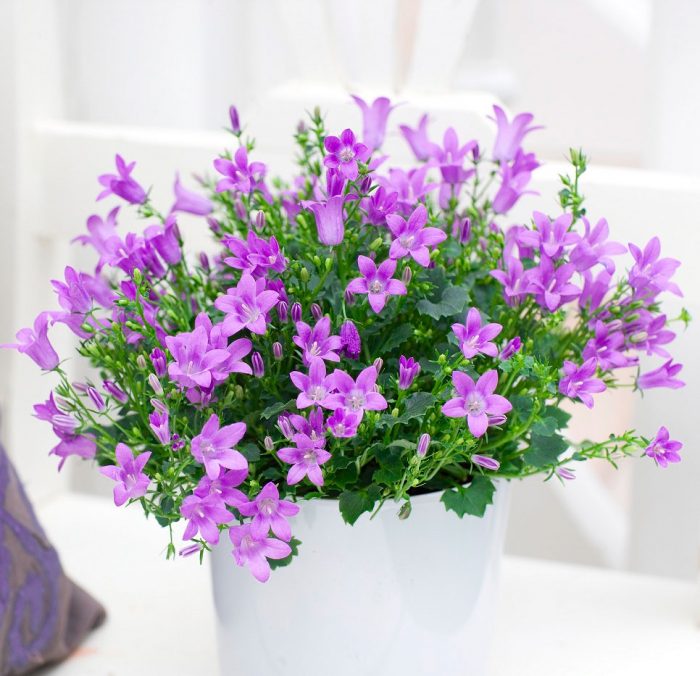
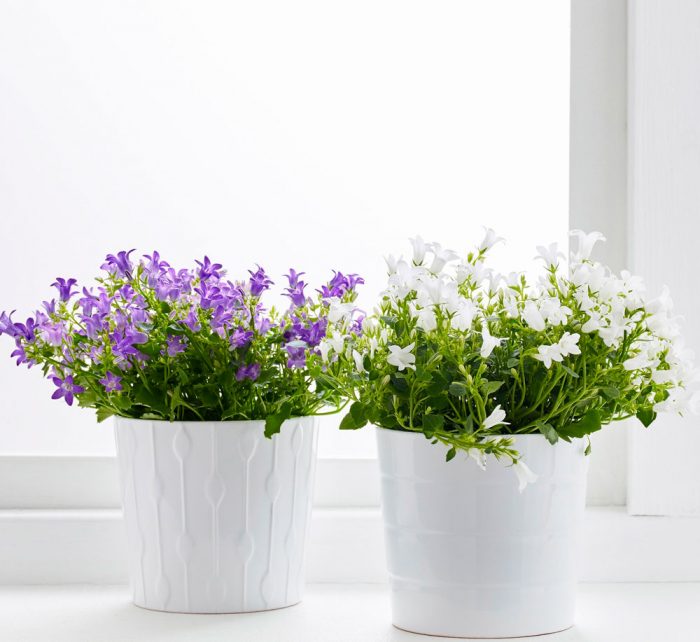
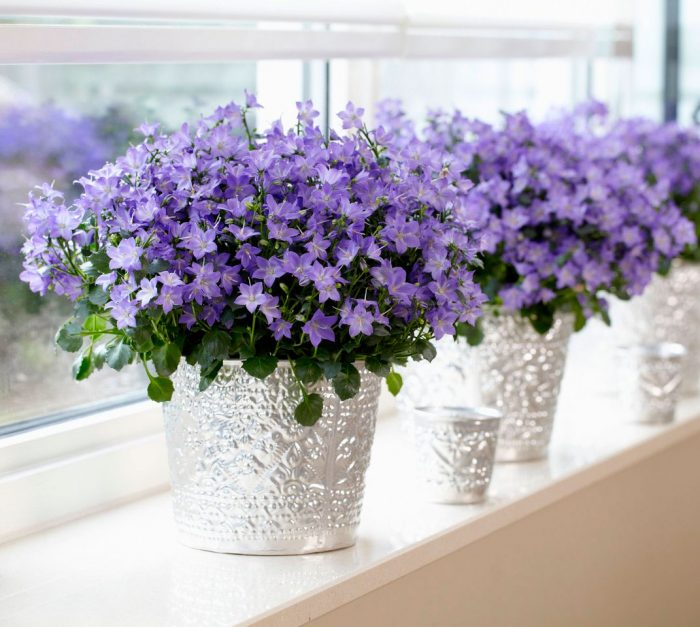
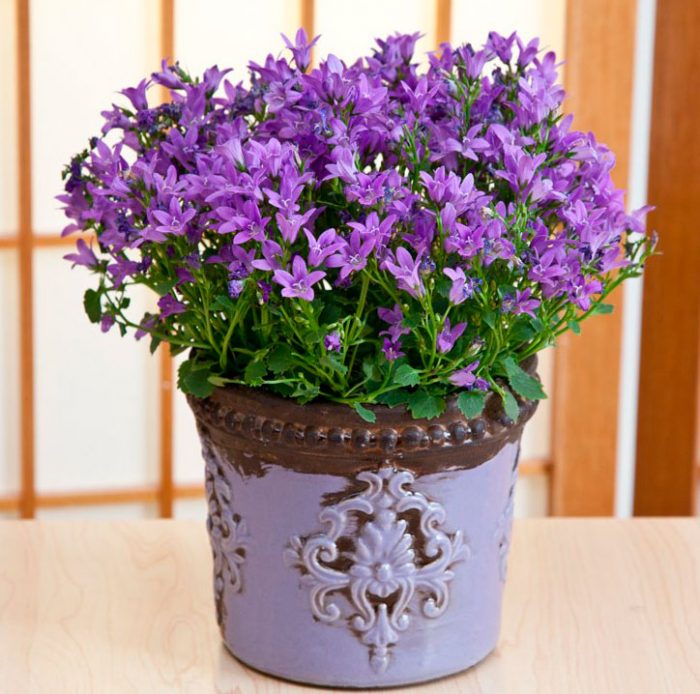
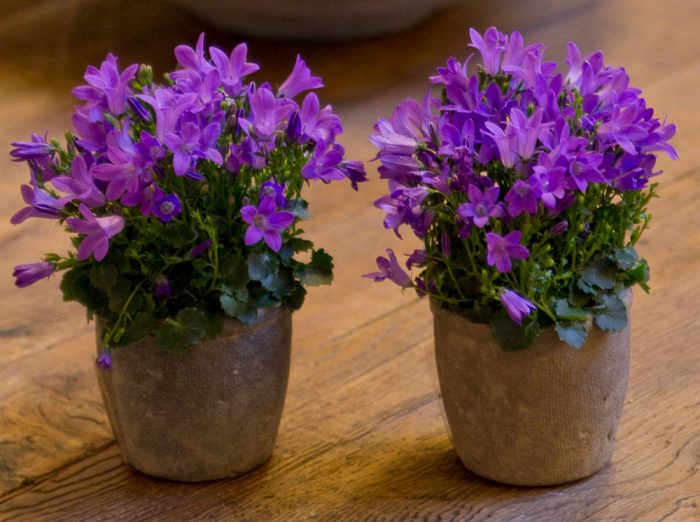
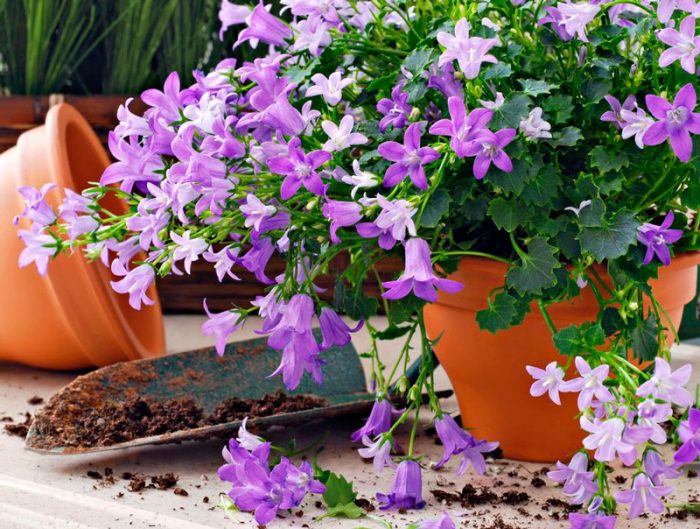
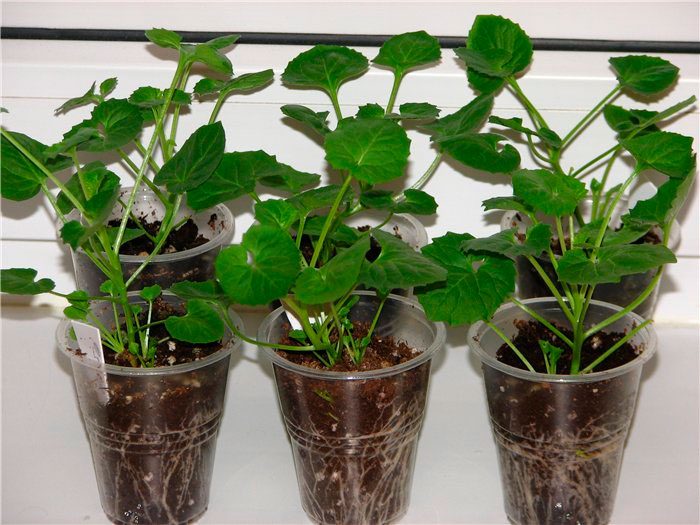
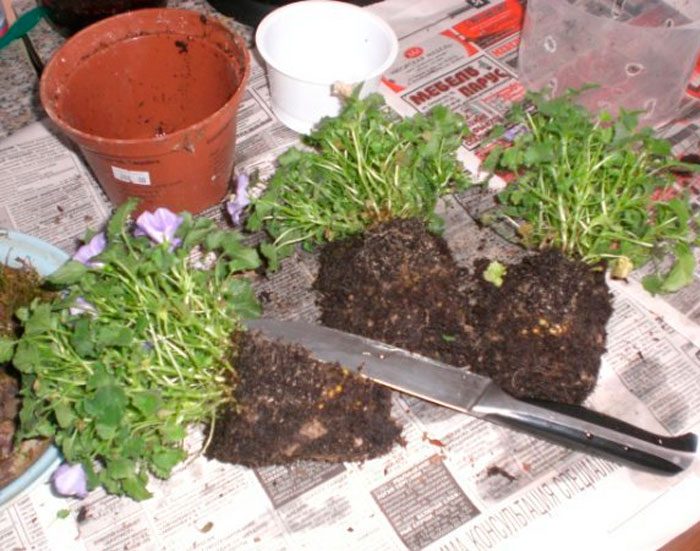

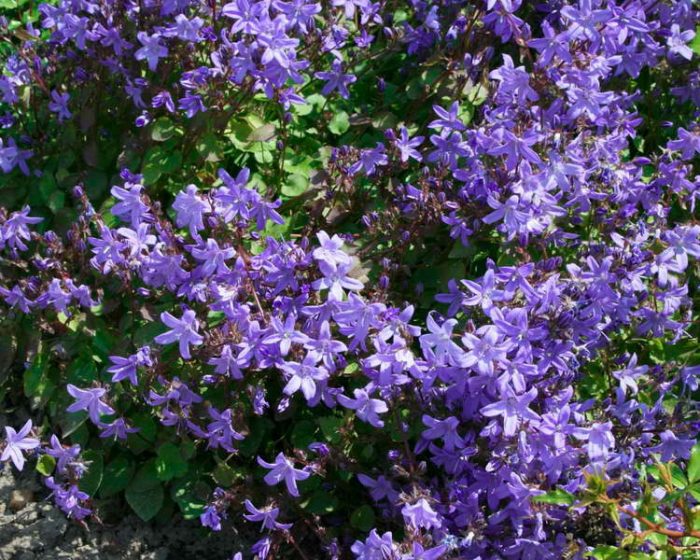

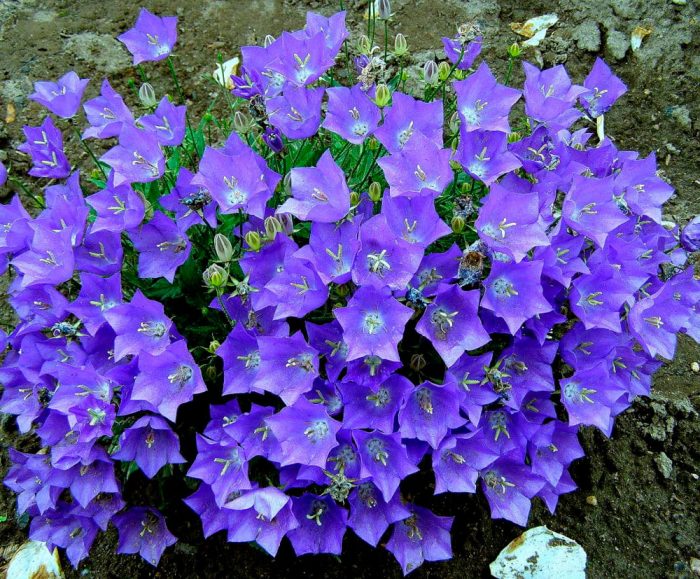










The peculiarities of caring for this plant are only specialized greenhouse conditions. At home, no matter how worn, it will not live for more than 2 weeks, it will dry out. Even agronomists could not save in a specialized flower supermarket - it was dry, like my house. Therefore, do not fool with the purchase, although it is difficult to resist, it is very beautiful. I had a terry campanula for a short time.
Irina, you are wrong, in May 2018 I bought a blue campanula, it bloomed, I have it until autumn, then I cut it off and put it on a sunny window to winter (on the windowsill in winter + 17), in the spring of 2019 in May I removed it to the balcony, and she still blooms